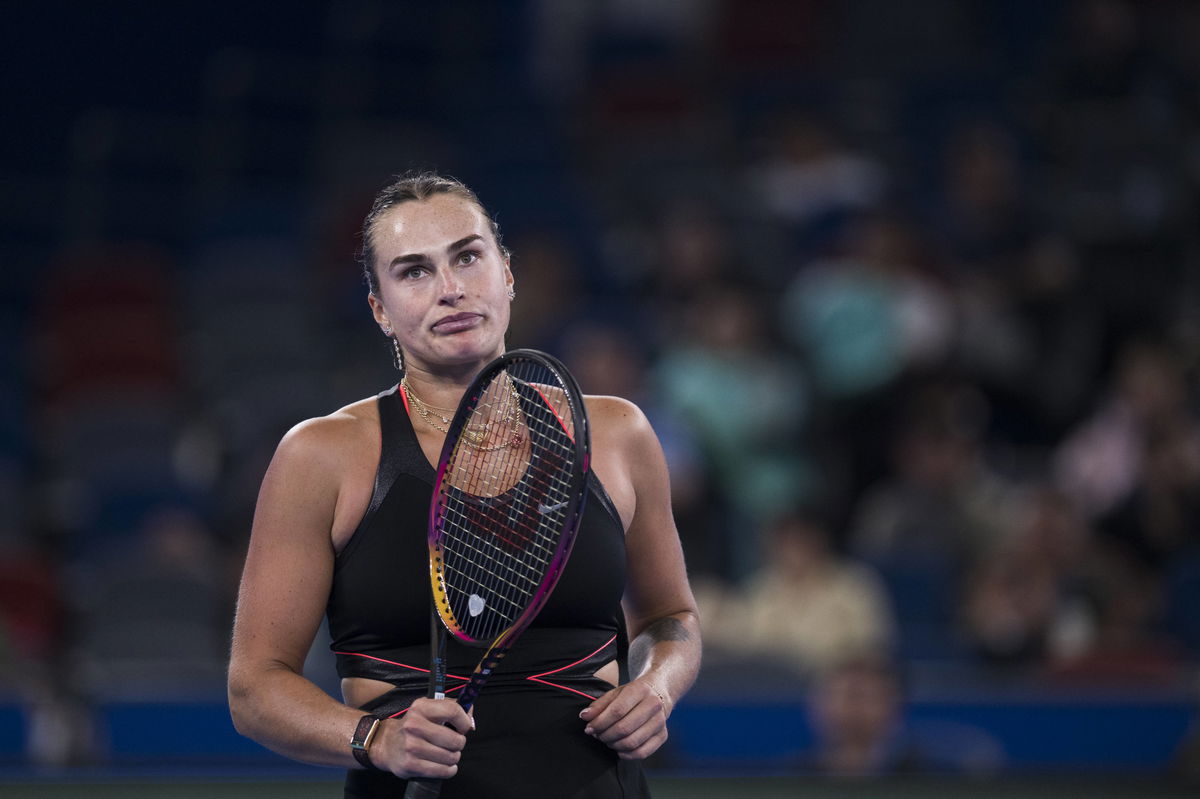
Imago
251011 — WUHAN, Oct. 11, 2025 — Aryna Sabalenka reacts during the women s singles semifinal between Jessica Pegula of the United States and Aryna Sabalenka of Belarus at the 2025 Wuhan Open tennis tournament in Wuhan, central China s Hubei Province, Oct. 11, 2025. SPCHINA-WUHAN-TENNIS-WUHAN OPEN-WOMEN S SINGLES CN WuxZhizun PUBLICATIONxNOTxINxCHN

Imago
251011 — WUHAN, Oct. 11, 2025 — Aryna Sabalenka reacts during the women s singles semifinal between Jessica Pegula of the United States and Aryna Sabalenka of Belarus at the 2025 Wuhan Open tennis tournament in Wuhan, central China s Hubei Province, Oct. 11, 2025. SPCHINA-WUHAN-TENNIS-WUHAN OPEN-WOMEN S SINGLES CN WuxZhizun PUBLICATIONxNOTxINxCHN
Aryna Sabalenka, the reigning World No. 1 and a four-time Grand Slam champion, with back-to-back titles at the 2023 and 2024 Australian Open and the 2024 and 2025 US Open, has established herself as one of the most dominant forces on the WTA Tour. But recently, Sabalenka opened up about a difficult chapter in her career, admitting she was once so frustrated by her struggles with double faults that she nearly walked away from the sport altogether.
Watch What’s Trending Now!
Just hours ago, @Livieparis2024 shared a clip on X where the 27-year-old details how close she came to giving up and how that conversation changed everything. “I thought maybe it’s time to walk away, maybe that’s my fate,” she recalled. But it was her fitness coach, Jason Stacy, who changed everything when he reminded her of one last option: biomechanics. “He goes, ‘Wait, we haven’t tried biomechanics yet,’” Sabalenka said. That single suggestion turned out to be a game-changer in her career.
Looking back at 2022, it’s easy to understand why Aryna Sabalenka felt so lost. She started the season in Adelaide against Kaja Juvan, where 18 double faults cost her the match. The following week, she hit 21 more in another loss to qualifier Rebecca Peterson. Even at the Australian Open, she opened her match against Wang Xinyu with nine double faults in her first two service games and 12 in the first set. Somehow, she still pulled off the win, but the problem only grew worse, and by the end of that year, she had recorded a staggering 428 double faults.
ADVERTISEMENT
To think Aryna almost retired if it wasn't for Jason Stacy!!!! Sabalenka did 428 double faults in 2022 and thought about quitting luckily Jason her fitness coach told her " wait we haven't tried biomechanics yet" 😭😭😭😭 and the rest is history. pic.twitter.com/DJnra8oGHW
— Liviefromparis 🇫🇷🤸🏼♀️🎾 (@Livieparis2024) November 12, 2025
By season’s end, Aryna Sabalenka was exhausted and ready to call it quits. She told her team she was done. That’s when Stacy convinced her to give biomechanics a chance. “I was so desperate, I was ready to do anything to fix it,” she admitted. The decision turned out to be the turning point she needed.
However, after hiring a bio-mechanist, Sabalenka said her serve was completely transformed. “They completely overhauled my serve,” she explained. When asked if the process involved “sensors stuck on you,” she laughed and clarified, “No, not like sensors or anything. It’s basically about technique, how to use your body with less effort and more efficiency because there’s still physics, right? How to actually send a ball over the net into that little box.”
ADVERTISEMENT
And the results spoke for themselves. Ever since she adopted biomechanics, Sabalenka’s double faults have never outnumbered her aces, not in 2024, and not so far in 2025.
Now, even though she has conquered her serving demons, the challenges haven’t stopped coming, as most recently, Elena Rybakina defeated her 6-3, 7-6(0) to claim the WTA Finals title. And if that wasn’t enough, former World No. 1 Caroline Wozniacki has now called for a WTA rule change targeting the style of play of stars like Sabalenka. Why, you ask?
ADVERTISEMENT
Possible WTA rule change might put Aryna Sabalenka at risk
Caroline Wozniacki has experienced every shade of tennis, from its toughest moments to its most beautiful. So recently, when John Isner asked her what rule change she would introduce on the WTA Tour, the 35-year-old had a thoughtful answer ready. Drawing from years of experience, she suggested something few had dared to formalize before: controlling the volume of players’ grunts during matches.
“There should be like a mic and there should be a decibel thing, so you can’t grunt over a certain level. I think that should be a rule. And also the length of the grunt,” Wozniacki said. But why is grunting so controversial in tennis?
ADVERTISEMENT

Imago
Source: Imago
According to Wozniacki, the main problem is that it distracts opponents during rallies. “You can’t hear someone hit the ball properly when someone is screaming so loud,” she explained. “I think it really disturbs the opponent in some way. And I think as a fan, you don’t really want to listen to that either.” Her comments reflected a sentiment shared by many on tour who feel excessive noise crosses the line from natural expression to gamesmanship.
Still, research shows that grunting might offer real performance benefits: adding power, rhythm, or focus to a player’s shot. At Wimbledon 2025, Aryna Sabalenka’s now-famous grunt became a talking point when its sound level was compared to that of a car horn or even a lion’s roar. Sabalenka herself commented on the issue, saying, “How can you scream when you hit the ball, but you still screaming when I hit the ball? This is hindrance.” She even joked that if no action was taken, she might “scream when she hits next time we play.”
ADVERTISEMENT
Anyway, throughout her own career, Wozniacki proved that tennis doesn’t need ear-splitting grunts to be intense. That said, do you think grunting gives players like Aryna Sabalenka a real competitive edge, or does it cross the line into distraction?
ADVERTISEMENT
ADVERTISEMENT
ADVERTISEMENT

